Related Research Articles

The 5.56×45mm NATO is a rimless bottlenecked intermediate cartridge family developed in the late 1970s in Belgium by FN Herstal. It consists of the SS109, L110, and SS111 cartridges. On 28 October 1980 under STANAG 4172 it was standardized as the second standard service rifle cartridge for NATO forces as well as many non-NATO countries. Though they are not entirely identical, the 5.56×45mm NATO cartridge family was derived from and is dimensionally similar to the .223 Remington cartridge designed by Remington Arms in the early 1960s.

The .40 S&W is a rimless pistol cartridge developed jointly by American firearms manufacturers Smith & Wesson and Winchester in 1990. The .40 S&W was developed from the ground up as a law enforcement cartridge designed to duplicate performance of the Federal Bureau of Investigation's (FBI) reduced-velocity 10mm Auto cartridge which could be retrofitted into medium-frame semi-automatic handguns. It uses 0.40-inch (10 mm) diameter bullets ranging in weight from 105 to 200 grains.
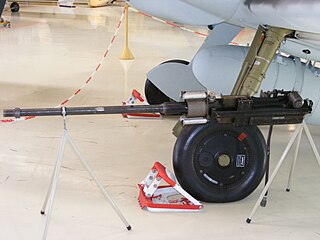
The MG 151 was a German 15 mm aircraft-mounted autocannon produced by Waffenfabrik Mauser during World War II. Its 20mm variant, the 20 mm MG 151/20 cannon, was widely used on German Luftwaffe fighters, night fighters, fighter-bombers, bombers and ground-attack aircraft. Salvaged guns saw post-war use by other nations.

The 9×19mm Parabellum is a rimless, tapered firearms cartridge.

The .338 Lapua Magnum is a rimless, bottlenecked, centerfire rifle cartridge. It was developed during the 1980s as a high-powered, long-range cartridge for military snipers. It was used in the War in Afghanistan and the Iraq War. As a result of this, it has become widely available.

The .22 Long Rifle or simply .22 LR is a long-established variety of .22 caliber rimfire ammunition originating from the United States. It is used in a wide range of rifles, pistols, revolvers, smoothbore shotguns, and submachine guns.

The 10mm Auto is a semi-automatic pistol cartridge introduced in 1983. Its design was adopted and later produced by ammunition manufacturer FFV Norma AB of Åmotfors, Sweden.

The Royal Ordnance L7, officially designated Gun, 105 mm, Tank, L7, is the basic model of the United Kingdom's most successful tank gun. The L7 is a 105 mm L/52 rifled design by the Royal Ordnance Factories intended for use in armoured fighting vehicles, replacing the earlier QF 20-pounder (84 mm) tank gun mounted on the Centurion tank. The successful L7 gun has been fitted on many armoured vehicles including the British Centurion, the German Leopard 1 and several variants of the US MBTs M48 Patton and M60.
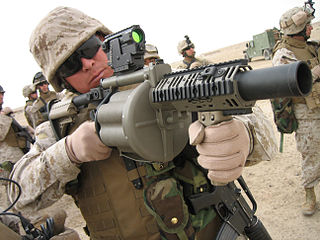
In current usage a riot gun or less-lethal launcher is a type of firearm that is used to fire "non-lethal" or "less-lethal" ammunition for the purpose of suppressing riots. Less-lethal launchers may be special purpose firearms designed for riot control use, or standard firearms, usually shotguns and grenade launchers, adapted to riot control use with appropriate ammunition. The ammunition is most commonly found in 12 gauge shotguns and 37mm/40 mm grenade launchers.

FV433, 105mm, Field Artillery, Self-Propelled "Abbot" is the self-propelled artillery, or more specifically self-propelled gun (SPG), variant of the British Army FV430 series of armoured fighting vehicles (AFVs), using much of the chassis of the FV430 but with a fully rotating turret at the rear housing the 105 mm gun and given the vehicle designation of FV433.
The 5.45×39mm cartridge is a rimless bottlenecked intermediate cartridge. It was introduced into service in 1974 by the Soviet Union for use with the new AK-74. The 5.45×39mm gradually supplemented and then largely replaced the 7.62×39mm cartridge in Soviet and Warsaw Pact service as the primary military service rifle cartridge.

The L118 light gun is a 105 mm towed howitzer. It was originally designed and produced in England for the British Army in the 1970s. It has since been widely exported. The M119 howitzer is a United States version that uses a different type of ammunition.

The 7.92×57mm Mauser is a rimless bottlenecked rifle cartridge. The 7.92×57mm Mauser cartridge was adopted by the German Empire in 1903–1905, and was the German service cartridge in both World Wars. In its day, the 7.92×57mm Mauser cartridge was one of the world's most popular military cartridges. In the 21st century it is still a popular sport and hunting cartridge that is factory-produced in Europe and the United States.

The 105 mm M101A1 howitzer is an artillery piece developed and used by the United States. It was the standard U.S. light field howitzer in World War II and saw action in both the European and Pacific theaters and during the Korean War. Entering production in 1941, it quickly gained a reputation for accuracy and a powerful punch. The M101A1 fires 105 mm high explosive (HE) semi-fixed ammunition and has a range of 12,330 yards (11,270 m), making it suitable for supporting infantry.

The M2 Mortar is a 60 millimeter smoothbore, muzzle-loading, high-angle-of-fire weapon used by U.S. forces in World War II, the Korean War, and the Vietnam War for light infantry support.
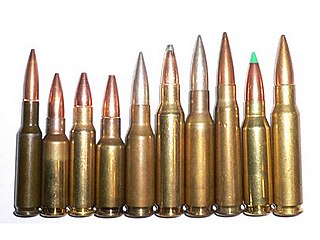
The 6×45mm SAW describes an experimental series of rimless bottlenecked intermediate cartridges developed in the 1970s for the U.S. Army. The cartridges were produced in a variety of sizes and from a variety of materials. The intent was to develop a cartridge that would replace all 5.56×45mm NATO weapons as well as most 7.62×51mm NATO rifles and machine guns in the U.S. military. Eventually, the 5.56mm was retained and only the machine gun portion of the SAW competition was successful. That program led to the M249 light machine gun.
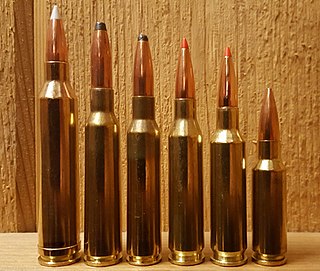
The 6.5mm Creedmoor (6.5×48 mm), designated 6.5 Creedmoor by SAAMI, 6.5 Creedmoor by the C.I.P. or 6.5 CM or 6.5 CRDMR for short, is a centerfire rifle cartridge introduced by Hornady in 2007. It was developed by Hornady senior ballistics scientist Dave Emary in partnership with Dennis DeMille, the vice-president of product development at Creedmoor Sports, hence the name. The cartridge is a necked-down modification of the .30 Thompson Center.
The M360 105mm Cartridge was a chemical artillery shell designed for use by the U.S. Army. It carried approximately 1.6 pounds (730 g) of GB.

The 7.62×51mm NATO is a rimless, bottlenecked rifle cartridge. It is a standard for small arms among NATO countries.
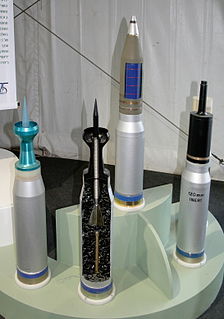
120×570mm NATO tank ammunition also known as 120×570 R is a common, NATO-standard, tank gun semi-combustible cartridge used by 120mm smoothbore guns, superseding the earlier 105×617mmR cartridge used in NATO-standard rifled tank guns.